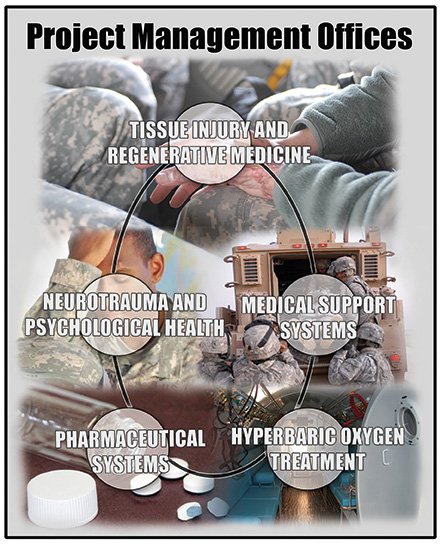USAMMDA's Project Management Offices' Mission and Purpose

The U.S. Army Medical Materiel Development Activity utilizes five different project management offices, each with its own project manager and product managers, in order to carry out its mission of delivering medical solutions to the Service Member.
What does a PMO do and how does it function?
PMOs make up the backbone of USAMMDA. Each PMO is chartered by the Principal Assistant for Acquisition office, headed by Dr. Kenneth Bertram, to conduct USAMMDA's mission.
The USAMMDA PMOs are: Medical Support Systems, Pharmaceutical Systems, Neurotrauma and Psychological Health, Tissue Injury and Regenerative Medicine, and Hyperbaric Oxygen Treatment. In addition to its charter, each PMO has a mission and a vision statement specific to its purpose.
The DoD 5000 policy establishes the Defense Acquisition System. It is under this system that the PMOs must operate.
"In accordance with the Army acquisition management process, we [the PMOs] are responsible for overseeing and directing all aspects of cost, schedule and performance of the products under our authority," said Michael Husband, acting deputy commander for acquisition and project manager of the Neurotrauma and Psychological Health PMO. "We call our adaptation of the acquisition process ‘Decision Gate'."
Decision Gate ensures that the U.S. Federal Drug Administration approval process gets integrated into the Department of Defense acquisition system. All PMOs follow the Decision Gate process and adapt it to meet their needs. The acquisition system itself ensures that quality products are developed in a timely manner at a reasonable price. Formal Milestone Decision Authority approval at specified points in the product life cycle must be obtained. Timelines and milestones vary based on the different products. Thus the time between milestones for drug development under Pharmaceutical Systems will usually be longer than those for solutions delivered under Medical Support Systems; mainly due to the complex nature of pharmaceutical clinical trials and FDA regulations.
For those PMOs which need FDA approval, Husband stresses the importance of USAMMDA's Division of Regulated Activities and Compliance and the Clinical Services Support Division. Their responsibility is to provide guidance and support when conducting clinical trials and progressing through the FDA regulatory process.
The PMOs' products are requirements driven. Capability gaps are identified by comparing what needs to be done with what can currently be done. If a materiel product is identified as the solution needed to close the gap, it is the job of the PMOs to look for one.
Within acquisition guidelines, PMOs are given some leeway as to how they solve capability gaps. In the case of the Neurotrauma and Psychological Health PMO, Husband, who was a product manager for the Medical Devices PMO at the U.S. Army Medical Materiel Agency two years ago, was able to bring his background and incorporate some of his past successes into the PMO to teach and guide his product managers. This process is on-going and allows for the evolution of the PMO.
Where do PMOs get the technology to solve their materiel solution needs?
"From everywhere we can," said Husband. "Part of our job is conducting market research and considering all sources of potential solutions. We are trying to translate research into products for the Warfighter. We look at all potential solutions, and then we funnel it down and refine it to what is best for the user's need."
The PMOs have relationships with Army labs, Army partners, commercial industry, universities and more. Joint Program Committees, made up of DOD and non-DOD medical and military technical experts, are the PMOs' science and technology partners. Each of the six JPCs specializes in a different area, and the PMOs integrate with them to meet their own specific needs. For instance, the Neurotrauma and Psychological Health PMO works with JPC6 Combat Casualty Care for Neurotrauma, while the Pharmaceutical Systems PMO works with JPC6 for blood products.
"It's the work of the PMO to take resources and leverage them to bring products to market. We do that by building relationships with industry partners as we rarely have enough money to complete a project from beginning to end," said Dr. Lawrence Lightner, project manager of the Pharmaceutical Systems PMO.
Commercialization of a USAMMDA-developed product is important. USAMMDA does not make any products itself, so there needs to be a supplier for the finished product. Also, according to Lightner, USAMMDA does not have the regulatory resources to manage products once they are licensed with the FDA. They need to work with an industry partner that does have the capability to meet FDA post-licensure requirements.
Creation of the PMOs themselves is an evolutionary process. The Army uses a system known as Roles of Care in order to distribute medical resources and capabilities at progressive levels in order to provide care to the Service Member. Originally, USAMMDA's focus was in providing products for Roles of Care 1-3, which take place in theater and care for the Service Member from initial first-aid and on to a Combat Support Hospital if needed.
"But, as conflicts are winding down, we realized we also need to focus on Roles 4 and 5 [where Soldiers receive care in brick and mortar hospitals both in theater and then in the United States.] We're making Warfighters whole, so we are more on the back-end. That's why the newer PMOs [TIRM and NPH] were created and focus on those capability gaps," said Husband.
USAMMDA's PMOs will always be needed as new capability gaps are identified. And as the nature of those gaps change, the procedures those PMOs follow may change and new PMOs may be created. A PMO is only as successful as its people. It needs a resourceful project manager to lead its team of product managers and support staff in finding ways to provide materiel solutions to the Service Member.













